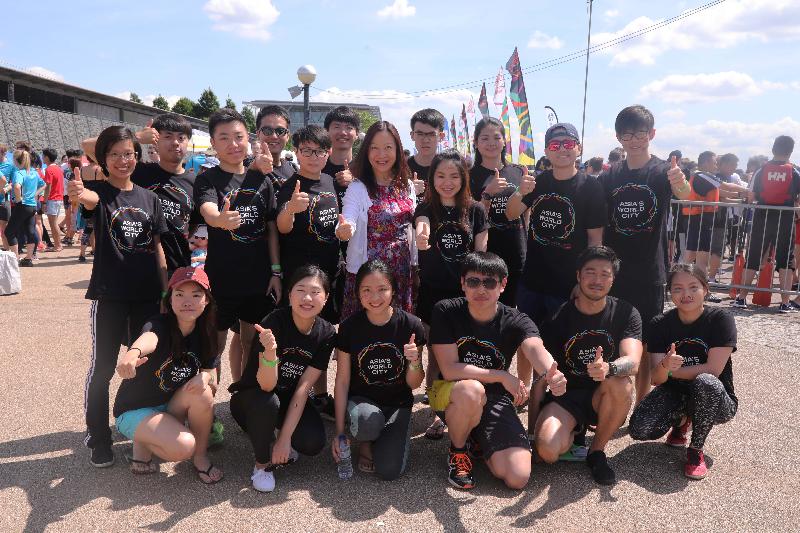Speech by SFST at 17th HKVCA China Private Equity Summit (English only)
Following is the speech by the Secretary for Financial Services and the Treasury, Mr James Lau, at the 17th Hong Kong Venture Capital and Private Equity Association (HKVCA) China Private Equity Summit today (June 5):
Eric (Chairman of the HKVCA, Mr Eric Mason), Conrad (Conference Chairman, 17th HKVCA China Private Equity Summit, Mr Conrad Tsang), distinguished guests, ladies and gentlemen,
Good morning. I am delighted to join you all today to share my thoughts on the opportunities for private equity in China's new era of economic development.
The remarkable story of China's economic transformation is well documented. According to the IMF, China's GDP in 1980 was US$305 billion, amounting to 2.7 per cent of the world's GDP. Last year, China's GDP was over US$12 trillion, amounting to 15 per cent of the world's GDP, but it contributes some 30 per cent of global economic growth.
In terms of trade, China's total trade amounted to US$21 billion in 1978, accounting for 0.8 per cent of the world total. Last year, the amount was over US$4 trillion, accounting for 11.5 per cent of the world total, making China the largest trading entity out of 204 economies.
In 2018, 40 years after the start of China's economic reform, China's GDP has grown by over 40 times over the period. China's latest development strategies continue to provide plentiful investment opportunities for private equity.
First, China is moving from an investment-based economy to one where consumption now is a key component of growth. There will continue to be strong appetite for retail products, increased expenditure on leisure pursuits and robust demand for education and healthcare.
In particular, I would like to highlight the active role of private equity in the healthcare industry. According to Asian Venture Capital Journal, private equity investments in China's healthcare industry totalled US$2 billion in 2017, up from US$686 million in 2016. Indeed, Beijing's policy reforms aimed at building a competitive healthcare industry have drawn in private investment in what McKinsey estimates could be a US$1 trillion industry by 2020.
Relevant to the consumer theme is an interesting investment thesis by Morgan Stanley economists, arguing that it is the smaller cities that will drive China's consumption boom. In a recent report, the investment bank estimated that China's private consumer market will grow from its current US$4.4 trillion to US$9.7 trillion and account for 47 per cent of China's GDP by 2030, and that lower-tier cities will fuel two thirds of the national consumption increase from 2017 to 2030.
This is not surprising because there is some consumption catching up to do for the increasingly prosperous smaller cities. The relative affordability of properties in lower-tier cities together with more flexible official residency policy could bring better social security coverage and reduce the need for precautionary passive savings. This would mean lower living costs and higher consumption power in lower-tier cities.
Secondly, China is seeking to transform itself from the "factory of the world" to an entrepreneurial and innovation base driven by more high value-added industries.
Today, China is home to a dynamic start-up scene and has emerged as a global leader in Internet finance. Underpinned by a huge domestic market, a high mobile penetration rate, and an open and supportive regulatory environment, China has embraced a development strategy with innovation at its heart.
Last year, more than half of the 406 blockchain-related patent applications in the World Intellectual Property Organization's database were from China. Various studies have highlighted China's numerous investments in artificial intelligence, in applications ranging from drones to autonomous vehicles.
According to a report released by the Hurun Research Institute in April this year, China had more than 150 unicorns at the end of March, with a combined value of over RMB4 trillion, around US$630 billion. These include over 30 new unicorns that were added to the list in the first quarter of this year. In comparison, data from CB Insights suggests that the US is home to around 235 unicorns worth US$812 billion.
What is interesting is that the start-ups in China appear to be scaling up faster than those in the United States. A report by the Boston Consulting Group suggests that Chinese tech start-ups are reaching the US$1 billion mark for unicorns three years faster than their U.S. counterparts, taking an average of four years, compared to seven for American companies.
One observation in this space is in relation to the role played by corporate investors such as Alibaba and Tencent, which have invested in many unicorns in China. On the one hand, China's technology giants may be competitors to private equity firms in chasing investment opportunities in promising start-ups. On the other hand, strategic sales to these companies can bring exit opportunities for venture capital investments by private equity firms.
Thirdly, China is keen to develop environmentally friendly cities and industries and has emerged as a leader in the global green economy. According to the Institute for Energy Economics and Financial Analysis, China was the biggest investor globally in renewable energy last year, with a total investment of US$44 billion in clean energy projects, a 40 per cent increase over US$32 billion in 2016.
Indeed, China currently accounts for around 60 per cent of global solar cell production, while the country's global presence in wind power is also rising. In addition, China is a bright spot for electric vehicle sales and plays a crucial role in the industry. Electric vehicles are expected to account for 34 per cent of global sales by 2035.
In fact, green funds are thriving in China. Aside from the Clean Development Mechanism Fund of the Ministry of Finance, many provinces and cities have established regional green development funds. Private green investment funds, such as the US-China Green Fund, have also been set up, and there are over 260 green funds registered with the Asset Management Association of China.
Fourthly, China is also the proponent of the Belt and Road Initiative, which aims to strengthen trade and promote investment along the Silk Road Economic Belt and the Maritime Silk Road. There is huge potential for private equity investments in infrastructure along the Belt and Road economies.
According to the Asian Development Bank, as much as US$1.7 trillion a year will need to be invested in infrastructure in Asia until 2030. The Asian Infrastructure Investment Bank puts the estimate at an even higher figure of US$2.7 trillion per year.
The Hong Kong Monetary Authority has set up an Infrastructure Financing Facilitation Office, which provides a platform for collaboration in infrastructure projects. To date, around 80 key stakeholders have joined as partners, including multilateral development banks, financiers, pension funds, insurance companies, commercial banks, professional services firms, and of course private equity funds.
Having looked at the four clusters of opportunities for private equity in China, let me now speak briefly on the types of investments we are likely to see for both private enterprises and state-owned enterprises.
One trend among private enterprises is the increase in buyouts by private equity firms. According to Bain & Company, the value of private equity buyout deals in Asia almost doubled to US$72 billion last year. In China, the growing number of buyout opportunities is attributed to the void in business succession that Mainland entrepreneurs face when their next generation does not want to take over their family businesses. Growing competition has also prompted first-generation entrepreneurs to seek operational transformation and resource injection for their companies.
Another trend we are seeing is increased opportunities to invest in state-owned enterprises in collaboration with state-owned restructuring funds, under ongoing mixed ownership reform. Private equity investors may be in a position to help state-owned enterprises improve their governance structure and implement more market-driven decision-making processes.
Finally, let me conclude by saying a few words on Hong Kong's role as a private equity hub. Hong Kong is the second largest private equity hub in Asia, just behind Mainland China. According to the Asian Venture Capital Journal, as at end-2016, the capital under management of private equity funds in Hong Kong amounted to US$120 billion. We have excellent financial infrastructure, a huge talent pool of investment and fundraising professionals, and strength in professional services such as law and accounting, all of which are essential to private equity businesses.
In addition, profits tax exemption for offshore funds was extended to private equity funds starting July 2015, and we are also currently studying the proposal to introduce a limited partnership regime in Hong Kong to make Hong Kong a more attractive location of domiciliation for private equity funds. Issues being considered include the legal framework for limited partnership as a fund vehicle as well as the associated tax treatment.
Last but not least, our vibrant equity market provides an exit option for private equity investments. Our Stock Exchange has just put in place a new listing regime for companies from emerging and innovative sectors, and we are already seeing sizeable applications under the new rules.
One major change to our listing requirements is tailor-made for biotech companies, taking into account their long and costly journey of turning research into effective products and applications. Biotech companies with no prior record of revenue or profit are now allowed to list on the Main Board of Hong Kong's Stock Exchange, subject to certain requirements. There is specific guidance for biotech sectors such as pharmaceuticals, biologics and medical devices.
The second listing change is to permit high growth and innovative companies with weighted voting rights (WVR) structures to list on the Main Board of our Stock Exchange, subject to requirements in market capitalisation, business model, role of research and development and track record in business operations.
Since companies with WVR structures potentially carry additional risks to investors, we have also put in place certain safeguards, such as requirements for WVR beneficiaries, limits on WVR powers and enhanced corporate governance and disclosure. Our safeguards introduce a higher standard of corporate governance and investor protection, and we believe this will attract more investor interest in such WVR companies.
In short, with appropriate safeguards in place, our listing reforms will deepen and broaden our fundraising platform and increase our overall competitiveness, thereby providing an attractive exit option for private equity investments.
Ladies and gentlemen, I attempted a tour of the horizon on the investment opportunities in private equity in China. China is a massive consumer market, home to a dynamic start-up scene, a leader in the global green economy, and the proponent of the Belt and Road Initiative. Hong Kong's experience, expertise and international connections allow us to be a vibrant private equity hub, and our recent listing reforms in particular present an attractive exit option for private equity investments. I am sure you are all well placed to capitalise on these opportunities and I wish you a successful conference. Thank you.






